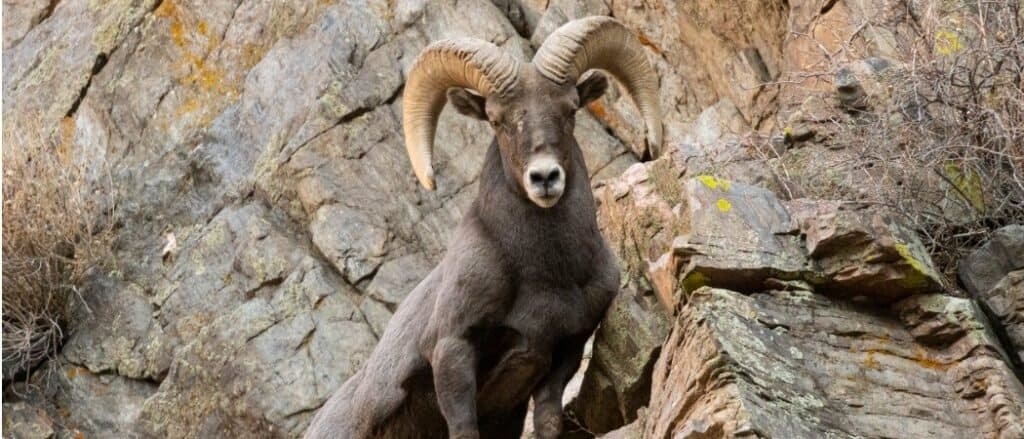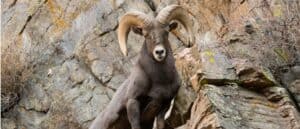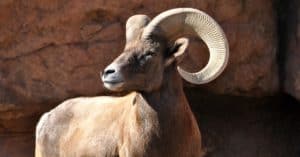For aspiring bighorn sheep hunters, Montana is the place to be! Many hunters note the Big Sky State is one of the best and easiest states to get a bighorn sheep hunting license. What’s more, Montana boasts a thriving population of these majestic ungulates. Below, we’ll be taking a look at the largest bighorn sheep specimen ever caught in Montana, its overall score and how to interpret it, and how it compares to the world record. In addition, we’ll cover how large bighorn sheep typically get, some interesting facts about them, and why they’re so uniquely prized by big game hunters!

Both sexes of bighorn sheep have horns, however, only the males have the large, spiraling horns prized by big game hunters.
©iStock.com/Gary Gray
Interesting Facts About Bighorn Sheep
Named for the massive, ornately curled horns on the males’ heads, the bighorn sheep, Ovis canadensis, is one of two species of mountain-dwelling sheep native to North America. Its thin-horned counterpart is the Dall sheep (Ovis dalli).
Both species originated in Siberia and share a common ancestor in the Siberian snow sheep (Ovis nivicola). Around 750,000 years ago, they crossed the Beringia land bridge that once connected Siberia with Alaska.
While Dall sheep mainly occupy northern Canada, bighorns live throughout southern Canada, the western United States, and northern Mexico. There are three subspecies of bighorn sheep. These subspecies mainly differ by genetic makeup and geographic range, though they are superficially similar in appearance and size.
To be clear, both sexes of bighorn sheep have horns. However, only the males have the large, spiraling horns prized by big game hunters. Females have much shorter, pointier horns. The males use their horns in displays of dominance when competing for mates. Their skulls are especially thick and bony to allow them to withstand the impact of ramming into other sheep. Both sexes also use their horns to tear into grasses, branches, and shrubs while foraging.
Fortunately, bighorn sheep’s bodies are ideal for living in a harsh, mountainous environment. Their large, wide-set eyes give them an exceptional field of vision, and their sense of hearing is incredibly sharp. Their stout, muscular bodies can run at speeds of up to 30 mph on flat ground, and they can scale even the steepest of slopes at up to 15 mph. They have thick, gray-brown coats that shed yearly in the summer and regrow over the fall and winter months. Finally, their hooves can easily grip mountainous surfaces, with a thick layer of keratin along the sides and a soft, flexible pad in the middle.

Bighorn sheep’s bodies are ideal for living in a harsh, mountainous environment.
©iStock.com/SWKrullImaging
How Big Do Bighorn Sheep Get?
In general, bighorn sheep have very bulky, muscular bodies. As a sexually dimorphic species, males are usually larger, wider, and taller than females. In addition to the obvious differences in the size and shape of their horns, their overall physiques also differ slightly.
In terms of height, the average male bighorn sheep usually reaches around 35 to 42 inches tall. By comparison, females of the species grow to around 30 to 35 inches in height. Males also tend to appear much taller than females due to their much larger and taller horns.
As you might expect, male bighorn sheep are also much more substantial in weight than the females. While adult male bighorns can weigh anywhere from 130 to 315 pounds, females range from 80 to 200 pounds on average.
Amazingly, male bighorn sheep horns can weigh up to 30 pounds! For many individuals, their horns can weigh almost as much as the rest of the bones in their body combined. They can grow to around three feet in length. However, due to the way their horns curl, they can appear much shorter. These horns do not stop growing when the sheep reaches maturity and can continue growing until they die.
It’s also worth noting that, out of the three known subspecies (Rocky Mountain, Sierra Nevada, and desert bighorn sheep), the Rocky Mountain variety is the largest. This is likely because Rocky Mountain bighorn sheep live in more steep, craggy, mountainous environments. As a result, they evolved over time to have slightly larger and more muscular bodies than the other two subspecies.

Rocky Mountain bighorn sheep are the largest of the bighorn subspecies.
©John Raptosh/Shutterstock.com
What Is The Largest Bighorn Sheep Ever Caught In Montana?
According to the Boone and Crockett Club, the largest bighorn sheep ever caught in Montana had a score of 216-3/8 in 2016. Incredibly, it’s also currently the largest bighorn sheep ever found in the world!
The sheep in question was a nine-year-old ram that lived and died in Lake County on Montana’s Wild Horse Island. Wild Horse Island is a 2,100-acre state park and the largest island in Flathead Lake. Notably, Flathead Lake is Montana’s largest freshwater lake.
Now, what does this score mean for the sheep’s actual size?
The official B&C system for scoring bighorn sheep is somewhat complicated for those unfamiliar with it. Essentially, it’s an assessment of the mass of the animal’s horns rather than its body weight or height.
Several measurements go into the score: the length of the horns and the circumferences of each horn at four different spots or quarters. The horn spread, or the distance between the tips of the horns, is measured but is not part of the final score. Hunters calculate the final score by adding together all of the measurements on both sides: the total length and the base, first, second, and third quarter circumferences of each horn.
Breaking things down a little more, the official scorecard for this new state and world record states the ram had nearly 50-inch-long horns with roughly 16-inch circumferences at their widest points!
By comparison, the largest hunter-taken bighorn sheep in Montana had a score of 208-3/8. Hunter Justin D. Sheedy secured this once-in-a-lifetime kill on October 20th, 2017, in Chouteau, Montana. According to its official scorecard, it had approximately 44-inch-long horns with nearly 18-inch circumferences at their bases. The scorecards for both sheep do not list their heights or weights, as these measurements do not factor into the scoring system.

The largest bighorn sheep ever caught in Montana had nearly 50-inch-long horns.
©iStock.com/randimal
Where Is Wildhorse Island, Montana Located On A Map?
Wildhead Island, located on Flathead Lake, is in the northwest region of the state, between Kalispell and Polson. Montana is located in the Mountain West region in the northwest of the United States. It shares a border with Idaho to the west, Wyoming to the south, North Dakota and South Dakota to the east, and the following Canadian provinces to the North: Alberta, British Columbia, and Saskatchewan.
The photo featured at the top of this post is © Georgia Evans/Shutterstock.com
Thank you for reading! Have some feedback for us? Contact the AZ Animals editorial team.







